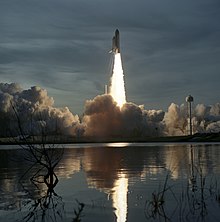STS-48
[2]: 28 UARS had ten sensing and measuring devices: Cryogenic Limb Array Etalon Spectrometer (CLAES); Improved Stratospheric and Mesospheric Sounder (ISAMS); Microwave Limb Sounder (MLS); Halogen Occultation Experiment (HALOE); High Resolution Doppler Imager (HRDI); Wind Imaging Interferometer (WlNDII); Solar Ultraviolet Spectral Irradiance Monitor (SUSIM); Solar/Stellar Irradiance Comparison Experiment (SOLSTICE); Particle Environment Monitor (PEM) and Active Cavity Radiometer Irradiance Monitor (ACRIM II).Images obtained during the flight were monochrome with 8 bits of digital information per pixel (256 gray levels) and stored on a removable hard disk.The images could be viewed and enhanced on board using a modified lap-top computer before being transmitted to the ground via the orbiter digital downlinks.However, due to weather conditions at KSC in Florida, Discovery flew one extra orbit and landed at Edwards Air Force Base, California, at 3:38 a.m. EDT on September 18, 1991.Video while in orbit on September 15, 1991, shows a flash of light and several objects that appear to be flying in an artificial or controlled fashion.

Upper Atmosphere Research SatelliteSpace Transportation SystemCOSPAR IDSATCAT no.Space ShuttleDiscoveryJohn Oliver CreightonKenneth S. Reightler Jr.Charles D. GemarJames BuchliMark N. BrownKennedyLC-39ARockwell InternationalEdwardsGeocentric orbitLow Earth orbitPerigee altitudeApogee altitudeInclinationPeriodAir Force Maui Optical SiteSpace Shuttle programSTS-43STS-44Kennedy Space CenterFloridaEdwards Air Force BasePositionCanadarmLaunch Complex 39Aozone layerupper atmosphereglobal photochemistryMicrowave Limb SounderActive Cavity Radiometer Irradiance MonitorNikon NASA F4monochromemodified lap-top computerCaliforniaPhilip C. PlaitBad AstronomyUFO HuntersProject GeminiApollo 15Elvis PresleyThe Bare NecessitiesThe Sherman BrothersDisneyThe Jungle BookPhil HarrisBruce ReithermanMowgliAre You Lonesome Tonight?Return to SenderList of human spaceflightsList of Space Shuttle missionsOutline of space sciencepublic domainPlait, Philip C.Wayback MachineSpace Shuttle DiscoverySTS-41-DSTS-51-ASTS-51-CSTS-51-DSTS-51-GSTS-51-ISTS-26STS-29STS-33STS-31STS-41STS-39STS-42STS-53STS-56STS-51STS-60STS-64STS-63STS-70STS-82STS-85STS-91STS-95STS-96STS-103STS-92STS-102STS-105STS-114STS-121STS-116STS-120STS-124STS-119STS-128STS-131STS-133Steven F. Udvar-Hazy CenterWashington, D.C.Destiny in SpaceU.S. Space Shuttle missions(crews)Approach and Landing TestsSTS-41-BSTS-41-CSTS-41-GSTS-51-BSTS-51-FSTS-51-JSTS-61-ASTS-61-BSTS-61-CSTS-51-LSTS-27STS-30STS-28STS-34STS-32STS-36STS-38STS-35STS-37STS-40